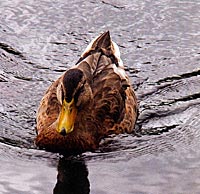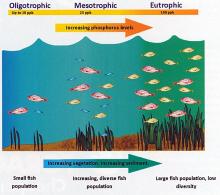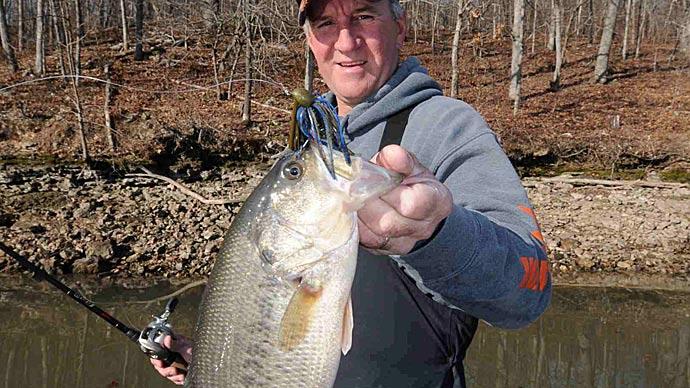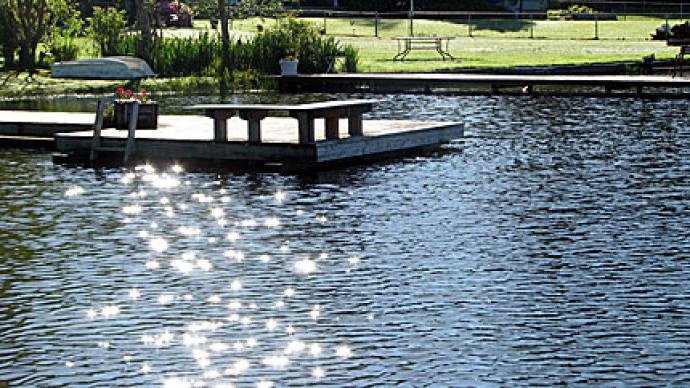Phosphorus: the 500-lb Gorilla
Phosphorus is a nutrient required for life by all the organisms in and around your pond or lake. In most freshwater environments, phosphorus is the limiting nutrient, which means it's usually the nutrient in shortest supply. But, in other parts of the country, phosphorus can be over-abundant. It's this keystone-like characteristic that makes phosphorus so influential in your pond and so important in pond management. Fertilizer treatments in ponds with low P can triple the number of fish and one pound of phosphorus is enough to produce up to 500 pounds of algae. Whether you want a gin-clear swimming pond or a monster bass honey hole, phosphorus plays an important role in your pond.
In a clear pond with low productivity (oligotrophic), phosphorus levels would typically be under 10 parts per billion (ppb). A pond with high productivity (eutrophic) will likely have about 96 ppb (Lory). When it comes to phosphorus the old saying "a little goes a long way" holds true. Want to turn that swimming hole into a fishing hole? It only takes about one- third of a pound, or about a shot glass full, of soluble reactive phosphorus per acre-foot of water (324,522 gallons) (Aquatic Eco-Systems) to raise the levels of P in your pond to eutrophic.
To help wrap your head around parts per billion (ppb), think of it in terms of steps. On an average day you probably take about 6,000 to 7,000 steps (About.com Walking). Now, try to imagine taking a billion steps...take a moment to wipe the sweat off your brow, but don't look down...you could be on the moon! So, whenever you hear talk about ppb, consider that just one of those steps on your trip to the moon is one part per billion.. .not a whole heck of a lot.
0.3 lbs of phosphorus
How did all this P get in the pond? Got This One in the Bag
Next time you see your neighbor out pushing the fertilizer spreader, think about this: fertilizers come in a variety of nutrient combinations. The three major nutrients present in fertilizers are nitrogen (N), phosphorus (P), and potassium (K). So, when you're picking out a terrestrial fertilizer and it says 10-10-10 on the bag, what does this mean? This tells you the concentrations in which the nutrients are present. A 55-pound bag of 10-10-10 fertilizer is 10% nitrogen, 10% phosphorus, and 10% potassium. This means it contains 5.5 pounds of each ingredient and enough phosphorus to raise levels in a 4-acre pond, 4 feet deep to a eutrophic status.
5 lbs of phosphorus = 55-lb bag of fertilizer
When It Rains, It Pours.
But what about runoff? As rain flows over the ground and into your pond, it brings with it nutrients from things like fertilizers and animal waste. In one urban landscape, runoff contained 0.3 pounds of phosphorus per acre per year (Graves; Neal C).
0.3 lbs of Phosphorus=lots of lbs phosphorus per acre per year. I'll let you do that math!
The Goose That Laid the Golden Egg (Sort Of)

Our ponds are home to many organisms and in some cases this includes waterfowl like ducks and geese. Did you know, the average goose dropping is 1.3% phosphorus and weighs approximately 1.2 grams (Lake Access)? Geese poop as many as 92 times a day—that's about one-third of a cup (Lake Access). That's about 1.4 grams of phosphorus a day or about .85 pounds of phosphorus per year, per goose. One goose produces enough phosphorus to make one million gallons of water have eutrophic levels. Now, think about this...someone had to follow a goose and watch it poop for a whole day to find that out. Aren't you glad you don't have that job?
.85 lbs of phosphorus = 59.86 lbs goose poop per year.
Make Like a Tree... and Leaf
The average mature oak tree will shed about 60 pounds of leaves over the course of a year. That doesn't seem like much until you realize that an average oak leaf weighs about 1.3 grams (a little less than a paperclip). Those 60 pounds of leaves can equate to about 1.5 pounds of phosphorus per year (Cowen). How many trees do you have over your pond?
1 -5 lbs of PhosPhorus = 60 lbs leaves.
Feeding Frenzy
Many fish foods boast phosphorus levels less than 1.3% (Yamato Green). Average phosphorus levels in fish foods are 0.6% to 1% (Hagen...For Pets; Zeigler). At these percentiles, a 55-pound bag of fish food contains 0.3 to .6 pounds of phosphorus. How many bags of feed do you use in a year's time. The good news? Most of that fish food becomes fish flesh, meaning the majority of phosphorus becomes fish.
0.5 lbs of phosphorus = 55-lb bag of fish feed
The Many Faces of Phosphorus Shiftier than a Tadpole in a Time Machine
We have discussed a few of the ways that phosphorus enters your lake, but where does all that phosphorus go? Phosphorus can exist in many different forms in your pond or lake. This is where it gets interesting. Even though phosphorus is in your water, it's important to remember that it's not all soluble reactive (ready to be used or absorbed). The phosphorus in your water can actually .shift into different forms. Fish and plants in your pond actually need phosphorus (like all living things) and absorb it into their systems for growth and everyday living. So when we say that phosphorus is "shifty" or that it "shifts" in the water column, this is what we mean. Phosphorus has many faces.
A Fine Kettle of Fish
Fish are huge consumers of phosphorus. On average, fish are about 2% phosphorus or, to make it easy, there are about 2 pounds of phosphorus per 100 pounds of fish (Walker). If 1 pound of phosphorus in the form of fish food is introduced into the water .15 to .3 pounds (15%-30%) will be absorbed by the fish (Food and Agriculture Organization of The United Nations).
2 lbs of phosphorus = 100 lbs of fish
Growing Like a Weed
Consider the plants that live in your pond. Two common ones you may have seen before are Eurasian water milfoil (Myriophyllum spicatum L.) and Curly leaf pond weed (Potamogeton crispus L.). Eurasian water milfoil contains .21 pounds of phosphorus per every 100 pounds of plant. By the same token, curly leaf pond weed holds about .23 pounds of phosphorus per 100 pounds of vegetation. (Madsen)
.23 lbs of phosphorus = 100 lbs curly leaf pond weed
Here is an interesting fact about phosphorus and water hyacinths. A case study done at the University of Florida showed when phosphorus levels in water are increased, water hyacinth plants significantly increase the amount of phosphorus they absorb from the water. Not only that, but they increased in number as well (Haller). Isn't it amazing how in some cases ponds and the organisms within them can adapt to maintain favorable conditions?
Pound for Pound
Now say this five times fast: For every pound of phosphorus present in your pond, 500 pounds of algae is produced!
1 lb. phosphorus = 500 lbs algae
To P or not To P?
That is the real question. As you now know, phosphorus enters your pond on the sly through fish and fish food, plants and fertilizers, runoff, rain, and even geese. Whether you need a pond high in productivity or prefer a pond that's clear, it's important to understand that phosphorus is the key to management in most scenarios. Knowing your phosphorus levels and understanding how influential it can be is essential to effective lake management.
Courtney Rickett is a Lake Technician and Biologist at Aquatic Eco-Systems, Inc. Matt Rayl is a Lakes Biologist and the Manager of the Lakes Department at Aquatic Eco-Systems, Inc.
Reprinted with permission from Pond Boss Magazine




